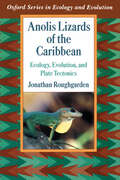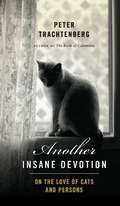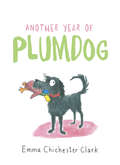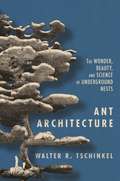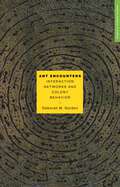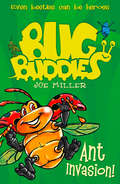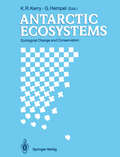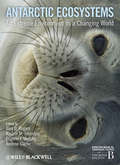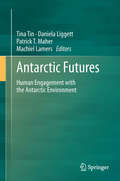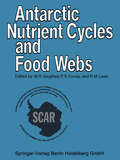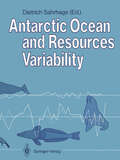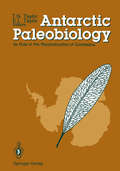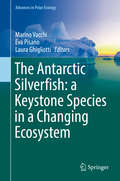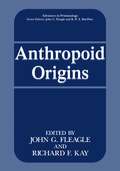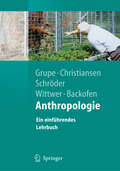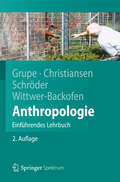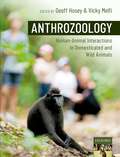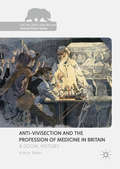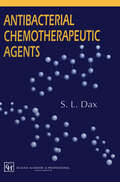- Table View
- List View
Anolis Lizards of the Caribbean: Ecology, Evolution, and Plate Tectonics (Oxford Series in Ecology and Evolution)
by Jonathan RoughgardenThe Anolis lizards of the Caribbean are ideally suited for the study of evolutionary ecology. Offering fascinating insights into the more than 150 species dispersed throughout the Caribbean islands, Jonathan Roughgarden details the differences between species in a wide range of behavioral and physical characteristics, including foraging behaviors, body size, and habitat use, resulting from evolutionary divergences concurrent with the plate-tectonic origins of the region. This book will be of interest to students and researchers--ecology and theoretical, tropical, and population biology.
Another Insane Devotion: On the Love of Cats and Persons
by Peter TrachtenbergFrom &“a genuine American Dostoevsky&” (The Washington Post): a dazzling, funny, bittersweet exploration of the mysteries of relationship, both human and animal.When his favorite cat Biscuit goes missing, Peter Trachtenberg sets out to find her. The journey takes him 700 miles and many years into his past-- into the history of his relationships with cats and the history of his relationship with his wife F., who may herself be on the verge of disappearing. What ensues is a work that recalls travel narratives from The Incredible Journey to W. G. Sebald&’s The Rings of Saturn. Trachtenberg ponders the mysteries of feline intelligence (why do cats score worse on some tests than pigeons?), the origins of their domestication, their terrible treatment during the Middle Ages. He also looks at the riddle of why any of us loves whom we love and all the unforeseen places to which that devotion leads us.
Another Year of Plumdog
by Emma Chichester ClarkIn 2014 Cape published Plumdog, a year’s worth of entries from Emma Chichester Clark’s blog of the same name which records the daily life of Plum, her dog, in Plum’s own words and Emma’s delightful illustrations. It was seized on by dog lovers everywhere and became the bestselling book written by a dog of that year … indeed quite possibly since records began.Another Year of Plumdog is exactly what it says: another year of leaping, catching balls, diving into rivers, puddles, the North Sea, and hanging out with friends.
Ant and Bee: An Alphabetical Story For Tiny Tots (Ant and Bee)
by Angela BannerThese were the books that taught me how to read' Anthony Horowitz.
Ant and Bee and the ABC (Ant and Bee)
by Angela BannerThe much-loved classic series of Ant and Bee books is designed for shared reading fun! First published in 1950, Ant and Bee were in print for over 40 years. These new editions feature revised text and illustrations by original Ant and Bee creator Angela Banner. The adorably small format is perfect for little hands.
Ant and Bee and the Doctor (Ant and Bee)
by Angela BannerThe much-loved classic series of Ant and Bee books is designed for shared reading fun! First published in 1950, Ant and Bee were in print for over 40 years. These new editions feature revised text and illustrations by original Ant and Bee creator Angela Banner. The adorably small format is perfect for little hands.
Ant Architecture: The Wonder, Beauty, and Science of Underground Nests
by Walter R. TschinkelAn unprecedented look at the complex and beautiful world of underground ant architectureWalter Tschinkel has spent much of his career investigating the hidden subterranean realm of ant nests. This wonderfully illustrated book takes you inside an unseen world where thousands of ants build intricate homes in the soil beneath our feet.Tschinkel describes the ingenious methods he has devised to study ant nests, showing how he fills a nest with plaster, molten metal, or wax and painstakingly excavates the cast. He guides you through living ant nests chamber by chamber, revealing how nests are created and how colonies function. How does nest architecture vary across species? Do ants have "architectural plans"? How do nests affect our environment? As he delves into these and other questions, Tschinkel provides a one-of-a-kind natural history of the planet's most successful creatures and a compelling firsthand account of a life of scientific discovery.Offering a unique look at how simple methods can lead to pioneering science, Ant Architecture addresses the unsolved mysteries of underground ant nests while charting new directions for tomorrow’s research, and reflects on the role of beauty in nature and the joys of shoestring science.
Ant Architecture: The Wonder, Beauty, and Science of Underground Nests
by Walter R. TschinkelAn unprecedented look at the complex and beautiful world of underground ant architectureWalter Tschinkel has spent much of his career investigating the hidden subterranean realm of ant nests. This wonderfully illustrated book takes you inside an unseen world where thousands of ants build intricate homes in the soil beneath our feet.Tschinkel describes the ingenious methods he has devised to study ant nests, showing how he fills a nest with plaster, molten metal, or wax and painstakingly excavates the cast. He guides you through living ant nests chamber by chamber, revealing how nests are created and how colonies function. How does nest architecture vary across species? Do ants have "architectural plans"? How do nests affect our environment? As he delves into these and other questions, Tschinkel provides a one-of-a-kind natural history of the planet's most successful creatures and a compelling firsthand account of a life of scientific discovery.Offering a unique look at how simple methods can lead to pioneering science, Ant Architecture addresses the unsolved mysteries of underground ant nests while charting new directions for tomorrow’s research, and reflects on the role of beauty in nature and the joys of shoestring science.
Ant Encounters: Interaction Networks and Colony Behavior
by Deborah M. GordonHow do ant colonies get anything done, when no one is in charge? An ant colony operates without a central control or hierarchy, and no ant directs another. Instead, ants decide what to do based on the rate, rhythm, and pattern of individual encounters and interactions--resulting in a dynamic network that coordinates the functions of the colony. Ant Encounters provides a revealing and accessible look into ant behavior from this complex systems perspective. Focusing on the moment-to-moment behavior of ant colonies, Deborah Gordon investigates the role of interaction networks in regulating colony behavior and relations among ant colonies. She shows how ant behavior within and between colonies arises from local interactions of individuals, and how interaction networks develop as a colony grows older and larger. The more rapidly ants react to their encounters, the more sensitively the entire colony responds to changing conditions. Gordon explores whether such reactive networks help a colony to survive and reproduce, how natural selection shapes colony networks, and how these structures compare to other analogous complex systems. Ant Encounters sheds light on the organizational behavior, ecology, and evolution of these diverse and ubiquitous social insects.
Ant Encounters: Interaction Networks and Colony Behavior (PDF)
by Deborah M. GordonHow do ant colonies get anything done, when no one is in charge? An ant colony operates without a central control or hierarchy, and no ant directs another. Instead, ants decide what to do based on the rate, rhythm, and pattern of individual encounters and interactions--resulting in a dynamic network that coordinates the functions of the colony. Ant Encounters provides a revealing and accessible look into ant behavior from this complex systems perspective. Focusing on the moment-to-moment behavior of ant colonies, Deborah Gordon investigates the role of interaction networks in regulating colony behavior and relations among ant colonies. She shows how ant behavior within and between colonies arises from local interactions of individuals, and how interaction networks develop as a colony grows older and larger. The more rapidly ants react to their encounters, the more sensitively the entire colony responds to changing conditions. Gordon explores whether such reactive networks help a colony to survive and reproduce, how natural selection shapes colony networks, and how these structures compare to other analogous complex systems. Ant Encounters sheds light on the organizational behavior, ecology, and evolution of these diverse and ubiquitous social insects.
Ant Invasion (Bug Buddies #3)
by Joe MillerEven bugs can be heroes! Join the Bug Buddies on bug-tastic adventures, as they pit their wits against the dreaded spider Spinner, creepiest of all creepy crawlies…
Antarctic Ecosystems: Ecological Change and Conservation
by K. R. Kerry G. HempelAntarctic Ecosystems comprises 55 papers presented at the Fifth Symposium on Antarctic Biology held under the auspices of the Scientific Committee on Antarctic Research (SCAR) in Hobart, Australia, 29 August - 3 September, 1988. Both short- and long-term changes in ecosystems and community structures caused by natural and human factors were discussed to help understand the ecological processes taking place in a changing environment. The variability of ecological factors must be known for the development of realistic monitoring strategies and sound conservation practices.
Antarctic Ecosystems: An Extreme Environment in a Changing World
by Alex D. Rogers Nadine M. Johnston Eugene J. Murphy Andrew ClarkeSince its discovery Antarctica has held a deep fascination for biologists. Extreme environmental conditions, seasonality and isolation have lead to some of the most striking examples of natural selection and adaptation on Earth. Paradoxically, some of these adaptations may pose constraints on the ability of the Antarctic biota to respond to climate change. Parts of Antarctica are showing some of the largest changes in temperature and other environmental conditions in the world. In this volume, published in association with the Royal Society, leading polar scientists present a synthesis of the latest research on the biological systems in Antarctica, covering organisms from microbes to vertebrate higher predators. This book comes at a time when new technologies and approaches allow the implications of climate change and other direct human impacts on Antarctica to be viewed at a range of scales; across entire regions, whole ecosystems and down to the level of species and variation within their genomes. Chapters address both Antarctic terrestrial and marine ecosystems, and the scientific and management challenges of the future are explored.
Antarctic Ecosystems: An Extreme Environment in a Changing World
by Alex D. Rogers Nadine M. Johnston Eugene J. Murphy Andrew ClarkeSince its discovery Antarctica has held a deep fascination for biologists. Extreme environmental conditions, seasonality and isolation have lead to some of the most striking examples of natural selection and adaptation on Earth. Paradoxically, some of these adaptations may pose constraints on the ability of the Antarctic biota to respond to climate change. Parts of Antarctica are showing some of the largest changes in temperature and other environmental conditions in the world. In this volume, published in association with the Royal Society, leading polar scientists present a synthesis of the latest research on the biological systems in Antarctica, covering organisms from microbes to vertebrate higher predators. This book comes at a time when new technologies and approaches allow the implications of climate change and other direct human impacts on Antarctica to be viewed at a range of scales; across entire regions, whole ecosystems and down to the level of species and variation within their genomes. Chapters address both Antarctic terrestrial and marine ecosystems, and the scientific and management challenges of the future are explored.
Antarctic Futures: Human Engagement with the Antarctic Environment
by Tina Tin Daniela Liggett Patrick T Maher Machiel LamersAt the beginning of the 21st century, Antarctica is poised at the edge of a warmer and busier world. Leading Antarctic researchers examine the needs and challenges of Antarctic environmental management today and tomorrow. Through: (i) investigating the impacts of human activities on specific ecosystems and species, (ii) examining existing environmental management and monitoring practices in place in various regions and (iii) interrogating stakeholders, they address the following questions: What future will Business-As-Usual bring to the Antarctic environment? Will a Business-As-Usual future be compatible with the objectives set out under the Antarctic Treaty, especially its Protocol on Environmental Protection? What actions are necessary to bring about alternative futures for the next 50 years? This volume is an outcome of the International Polar Year (2007-2009) Oslo Science Conference (8-12, June, 2010).
Antarctic Nutrient Cycles and Food Webs
by W. R. Siegfried P. R. Condy R. M. LawsIt is a pleasure and a distinct honour for me to greet the participants, guests and ob servers of this Fourth International Symposium on Antarctic Biology which has adopted nutrient cycles and food webs as its central theme. On behalf of the Scientific Committee on Antarctic Research (SCAR) and other bodies of the International Council of Scientific Unions (ICSU), I bid you welcome. SCAR is pleased to acknowledge the role of the co-sponsors for this Symposium which include the Scientific Committee on Oceanic Research (SCOR), the Interna tional Association of Biological Oceanography (IABO), and the International Union of Biological Sciences (IUBS). In addition, SCAR and its co-sponsors wish to acknowledge the financial support of the Council for Scientific and Industrial Re search (CSIR) and the Department of Transport (DOT) of the South African govern ment. Nor should we forget to acknowledge also the role of the South African Scientific Committee on Antarctic Research (SASCAR) and one of its leaders and Vice President of SCAR, Mr. Jan de Wit, in arranging this charming venue for this Symposium.
Antarctic Ocean and Resources Variability
by Dietrich SahrhageDuring the intensification of research activities in the Southern Ocean in recent years, both at national levels and through international cooperation in such projects as BIOMASS with its FIBEX and SIBEX phases, the need was felt increasingly for closer collaboration between biologists, meteorologists, and oceanographers in the study of the interaction between the atmospheric forces, the water masses, and the living resources. Better knowledge in this regard is not only of scientific interest but also of practical importance, especially for the management of the resources and the protection of the Antarctic marine ecosystem. As a follow-up on a recommendation by the IOC Program Group for the Southern Oceans made in March 1983, the Intergovernmental Oceanographic Commission organized a meeting of experts on oceanography related to the dynamics of the Antarctic ecosystems. During this meeting, held in Kiel, Federal Republic of Ger many, in May 1984, biologists and oceanographers involved in BIOMASS activities met with the oceanographers of SCOR Working Group 74 to discuss ways and means for additional physical and chemical observations in the oceanographic research within BIOMASS. It was the time when large fluctuations in the distribution of krill with subsequent detrimental effects on predator species dependent on krill had just been observed, and the question arose whether this was possibly the result of changes in the Antarctic water circulation.
Antarctic Paleobiology: Its Role in the Reconstruction of Gondwana
by Thomas N. Taylor Edith L. TaylorAntarctic Paleobiology discusses the current status of paleobiology, principally paleobotany and palynology in Antarctica, and the interrelationship of Antarctic floras to those of other Gondwana continents. It provides a broad coverage of the major groups of plants on the one hand, while on the other seeking to evaluate the vegetational history and the physical and biological parameters that influence the distribution of floras through time and space. The biologic activity is discussed within a framework of the geologic history, including the tectonic and paleogeographic history of the region. Finally, the reader will find a comprehensive bibliography of Gondwana paleobotany and palynology.
The Antarctic Silverfish: a Keystone Species in a Changing Ecosystem (Advances in Polar Ecology #3)
by Marino Vacchi Eva Pisano Laura GhigliottiThis book encompasses the body of available scientific information on the notothenioid fish Pleuragramma antarctica commonly known as Antarctic silverfish. This plankton-feeder of the intermediate trophic level is the most abundant fish in the coastal regions of high Antarctica, and plays a pivotal ecological role as the main prey of top predators like seals, penguins, whales and Antarctic toothfish. Broad circum-polar distribution, a key role in the Antarctic shelf pelagic ecosystem, and adaptations makes understanding the species’ likely response to environmental change relevant to foresee the potential responses at the local ecosystem level. Additionally, a detailed understanding of the abundance and trophic interactions of such a dominant keystone species is a vital element of informing the development of marine spatial planning and marine protected areas in the Antarctic continental shelf region.Experts in the field provide here unique insights into the evolutionary adaptation, eco-physiology, trophic ecology, reproductive and population ecology of the Antarctic silverfish and provide new clues about its vulnerability in facing the challenges of the ongoing environmental changes.
Anthropoid Origins (Advances in Primatology)
by John G. Fleagle Richard F. KayThis volume brings together information about recent discoveries and current theories concerning the origin and early evolution of anthropoid primates monkeys, apes, and humans. Although Anthropoidea is one of the most dis tinctive groups of living primates, and the origin of the group is a frequent topic of discussion in the anthropological and paleontological literature, the topic of anthropoid origins has rarely been the foeus of direct discussion in primate evolution. Rather, diseussion of anthropoid origins appears as a ma jor side issue in volumes dealing with the origin of platyrrhines (Ciochon and Chiarelli, 1980), in discussions about the phylogenetic position of Tarsius, in descriptions of early anthropoid fossils, and in descriptions and revisions of various fossil prosimians. As a result, the literature on anthropoid origins has a long history of argument by advocacy, in which scholars with different views have expounded individual theories based on a small bit of evidence at hand, often with little consideration of alternative views and other types of evidence that have been used in their support. This type of scholarship struck us as a relatively unproductive approach to a critical issue in primate evolution.
Anthropologie: Ein einführendes Lehrbuch (Springer-Lehrbuch)
by Gisela Grupe Kerrin Christiansen Inge Schröder Ursula Wittwer-BackofenDie Anthropologie versteht sich hier als Brückenfach zwischen Natur- und Geisteswissenschaften. Sie schließt auch die nächsten Verwandten der Menschen im Tierreich, die nicht-menschlichen Primaten, mit ein. Diese Einführung vermittelt die ganze fachliche Breite im Grundstudium. Basierend auf einem Vorschlag der „Gesellschaft für Anthropologie e.V.“
Anthropologie: Einführendes Lehrbuch (Springer-Lehrbuch)
by Gisela Grupe Kerrin Christiansen Inge Schröder Ursula Wittwer-BackofenAnthropologie, wörtlich übersetzt „die Lehre vom Menschen“, ist eine primär biologische Disziplin – mit vielfältigen kulturwissenschaftlichen Bezügen. In diesem aktuellen Lehrbuch zur Anthropologie reduzieren die Autorinnen deshalb die Biologie des Menschen nicht auf eine Zoologie des Menschen, sondern beziehen seine kulturelle Überformung mit ein. Der Band bietet eine Einführung in die wichtigsten Fragen und ist daher besonders für das Grundstudium geeignet. Für die Neuauflage wurden nahezu alle Kapitel erheblich erweitert und aktualisiert.
Anthrozoology: Human-Animal Interactions in Domesticated and Wild Animals
Anthrozoology, the study of human-animal interactions (HAIs), has experienced substantial growth during the past 20 years and it is now timely to synthesise what we know from empirical evidence about our relationships with both domesticated and wild animals. Two principal points of focus have become apparent in much of this research. One is the realisation that the strength of these attachments not only has emotional benefits for people, but confers health benefits as well, such that a whole area has opened up of using companion animals for therapeutic purposes. The other is the recognition that the interactions we have with animals have consequences for their welfare too, and thus impact on their quality of life. Consequently we now study HAIs in all scenarios in which animals come into contact with humans, whether as pets/companions, farm livestock, laboratory animals, animals in zoos, or in the wild. This topical area of study is of growing importance for animals in animal management, animal handling, animal welfare and applied ethology courses, and also for people within psychology, anthropology and human geography at both the undergraduate and postgraduate level. It will therefore be of interest to students, researchers, and animal managers across the whole spectrum of human-animal contact.
Anti-Vivisection and the Profession of Medicine in Britain: A Social History (The Palgrave Macmillan Animal Ethics Series)
by A.W.H. BatesThis book is open access under a CC BY 4.0 license.This book explores the social history of the anti-vivisection movement in Britain from its nineteenth-century beginnings until the 1960s. It discusses the ethical principles that inspired the movement and the socio-political background that explains its rise and fall. Opposition to vivisection began when medical practitioners complained it was contrary to the compassionate ethos of their profession. Christian anti-cruelty organizations took up the cause out of concern that callousness among the professional classes would have a demoralizing effect on the rest of society. As the nineteenth century drew to a close, the influence of transcendentalism, Eastern religions and the spiritual revival led new age social reformers to champion a more holistic approach to science, and dismiss reliance on vivisection as a materialistic oversimplification. In response, scientists claimed it was necessary to remain objective and unemotional in order to perform the experiments necessary for medical progress.
Antibacterial Chemotherapeutic Agents
by S.L. DaxOver the past 50 years a wide variety of antibacterial substances have been discovered and synthesised, and their use in treating bacterial infection has been spectacularly successful. Today there are several general classes of antibacterial drugs, each having a well established set of uses, and together they form the mainstay of modern antibacterial chemotherapy. In search for new and improved agents, the pharmaceutical researcher needs to be well informed on many topics, including existing agents, their modes of action and pharmacology, and possible synthetic approaches. In this new book the author has brought together a wide range of information on the principal classes of antibacterial agents, and he covers, for each group, their history, mode of action, key structural features, synthesis and bacterial resistance. The result is a compact and concise overview of these very important classes of antibacterial agents.
